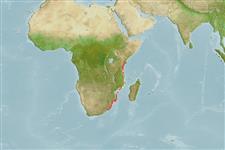Common names from other countries
Elasmobranchii (haaien en roggen) (sharks and rays) >
Rhinopristiformes (Shovelnose rays) >
Rhinobatidae (Guitarfishes)
Etymology: Rhinobatos: Greek, rhinos = nose + Greek, batis, -idos = a ray (Raja sp.) (Ref. 45335).
More on author: Norman.
Environment: milieu / climate zone / depth range / distribution range
Ecologie
marien demersaal; diepte 75 - 253 m (Ref. 11228). Deep-water; 2°S - 31°S, 30°E - 43°E (Ref. 114953)
Western Indian Ocean: Kenya to Natal, South Africa.
Grootte / Gewicht / Leeftijd
Maturity: Lm ? range ? - ? cm
Max length : 127 cm TL mannelijk / geslacht onbekend; (Ref. 3919)
Korte beschrijving
Determinatiesleutels | Morfologie | Morfometrie
A guitarfish with a narrow, sharply pointed snout and a narrow pectoral disc; nasal flaps extend only to the inner nostril edges (Ref. 5578). Plain olive-green above, without spots; prominent black blotch on underside of snout (Ref. 5578).
A rare and unknown species found offshore on the shelf (Ref. 5578). Ovoviviparous (Ref. 50449). Taken as bycatch of trawl and gillnet fisheries (Ref. 114953).
Levenscyclus en paargedrag
Maturities | Voortplanting | Spawnings | Egg(s) | Fecundities | Larven
Exhibit ovoviparity (aplacental viviparity), with embryos feeding initially on yolk, then receiving additional nourishment from the mother by indirect absorption of uterine fluid enriched with mucus, fat or protein through specialised structures (Ref. 50449).
Compagno, L.J.V., 1986. Rhinobatidae. p. 128-131. In M.M. Smith and P.C. Heemstra (eds.) Smiths' sea fishes. Springer-Verlag, Berlin. (Ref. 3919)
Status op de Rode Lijst van het IUCN (Ref. 130435)
Gevaar voor de mens
Harmless
Gebruik door de mens
Visserij: van geen belang
Tools
Speciale rapporten
Download XML
Internetbronnen
Estimates based on models
Preferred temperature (Ref.
115969): 18 - 22.3, mean 19.8 (based on 23 cells).
Fylogenetische diversiteitsindex (Ref.
82804): PD
50 = 0.5000 [Uniqueness, from 0.5 = low to 2.0 = high].
Bayesian length-weight: a=0.00295 (0.00151 - 0.00578), b=3.13 (2.96 - 3.30), in cm Total Length, based on LWR estimates for this (Sub)family-body shape (Ref.
93245).
Trofisch niveau (Ref.
69278): 3.8 ±0.4 se; based on size and trophs of closest relatives
Weerstandsvermogen (Ref.
120179): laag, minimale populatieverdubbelingstijd 4,5-14 jaar (Fec assumed to be <100).
Fishing Vulnerability (Ref.
59153): Very high vulnerability (76 of 100).
